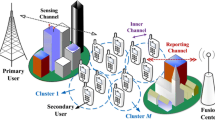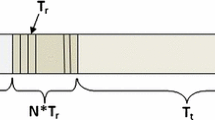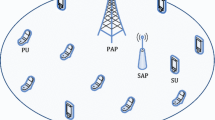Abstract
In cluster-based cooperative cognitive radio networks (CCRNs), spectrum sensing and decision making processes to determine whether the primary user (PU) signal is present or absent in the network are very important and vital issues to the utilisation of the idle spectrum. The reporting time delay is a very important matter to make quick and effective global decisions for the fusion center (FC) in a cluster-based CCRNs. In this paper, we propose the concept of multiple reporting channels (MRC) for cluster-based CCRNs to better utilize the reporting time slot by extending the sensing time of secondary users (SUs). A multiple reporting channels concept is proposed based on frequency division multiple access to enhance the spectrum sensing performance and reduce the reporting time delay of all cluster heads (CHs). In this approach, we assign an individual reporting channel to each cluster for reporting purposes. All the SUs in each cluster sequentially pass their sensing results to the corresponding cluster head (CH) via the assigned single reporting channel, which extends the sensing time duration of SUs. Each CH uses the dedicated reporting channel to forward the cluster decision to the FC that makes a final decision by using the “K-out-of-N” rule to identify the presence of the PU signal. This approach significantly enhances the sensing time for all SUs than the non-sequential as well as minimize the reporting time delay of all CHs than sequential single channel reporting approach. These two features of our proposed approach increase the decision accuracy of the FC more than the conventional approach. Simulation results prove that our proposed approach significantly enhances the sensing accuracy and mitigate the reporting time delay of CH compared to the conventional approach.











Similar content being viewed by others
Data Availability Statement
Not applicable.
References
Hesham, L., Sultan, A., Nafie, M., & Digham, F. (2012). Distributed spectrum sensing with sequential ordered transmissions to a cognitive fusion center. IEEE Transactions on Signal Processing, 60(5), 2524–2538.
Bera, D., Chakrabarti, I., & Pathak, S. S. (2016). Modelling of cooperative spectrum sensing over rayleigh fading without CSI in cognitive radio networks. Wireless Personal Communications, 86(3), 1281–1297.
Rammyaa, B., Vishvaksenan, K. S., Poobal, S., & Krishnan, M. M. M. (2019). Coded downlink MIMO MC-CDMA system for cognitive radio network: Performance results. Cluster Computing, 22(4), 8371–8378.
Manimegalai, M., & Bhagyaveni, M. A. (2019). A method to enhance the throughput of cognitive radio network using Kullback Leibler divergence with optimized sensing time (KLDOST). Wireless Personal Communications, 109(3), 1645–1660.
Ali, A., & Hamouda, W. (2016). Advances on spectrum sensing for cognitive radio networks: Theory and applications. IEEE Communications Surveys & Tutorials, 19(2), 1277–1304.
Surampudi, A., & Kalimuthu, K. (2016). An adaptive decision threshold scheme for the matched filter method of spectrum sensing in cognitive radio using artificial neural networks. In 2016 1st India international conference on information processing (IICIP) (pp. 1–5). IEEE.
Chatterjee, S., Banerjee, A., Acharya, T., & Maity, S. P. (2014). Fuzzy c-means clustering in energy detection for cooperative spectrum sensing in cognitive radio system. In International workshop on multiple access communications (pp. 84–95). Cham: Springer.
Gato, L. M., Martínez, L., & Torres, J. (2015). Blind spectrum sensing based on cyclostationary feature detection. InIberoamerican congress on pattern recognition (pp. 535–542). Cham: Springer.
Kortun, A., Ratnarajah, T., Sellathurai, M., Zhong, C., & Papadias, C. B. (2010). On the performance of eigenvalue-based cooperative spectrum sensing for cognitive radio. IEEE Journal of Selected Topics in Signal Processing, 5(1), 49–55.
Awe, O. P., & Lambotharan, S. (2015). Cooperative spectrum sensing in cognitive radio networks using multi-class support vector machine algorithms. In 2015 9th international conference on signal processing and communication systems (ICSPCS) (pp. 1–7). IEEE.
Kang, B. J. (2009). Spectrum sensing issues in cognitive radio networks. In 2009 9th international symposium on communications and information technology (pp. 824–828). IEEE.
Sun, M., Zhao, C., Yan, S., & Li, B. (2016). A novel spectrum sensing for cognitive radio networks with noise uncertainty. IEEE Transactions on Vehicular Technology, 66(5), 4424–4429.
Mahendru, G., Shukla, A., & Banerjee, P. (2020). A novel mathematical model for energy detection based spectrum sensing in cognitive radio networks. Wireless Personal Communications, 110(3), 1237–1249.
Miah, M. S., Schukat, M., & Barrett, E. (2018). An enhanced sum rate in the cluster based cognitive radio relay network using the sequential approach for the future Internet of Things. Human-centric Computing and Information Sciences, 8(1), 16.
Miah, M. S., Schukat, M., & Barrett, E. (2017). Maximization of sum rate in AF-cognitive radio networks using superposition approach and n-out-of-k rule. In 2017 28th Irish signals and systems conference (ISSC) (pp. 1–6). IEEE.
Yadav, K., Roy, S. D., & Kundu, S. (2020). Defense against spectrum sensing data falsification attacker in cognitive radio networks. Wireless Personal Communications, 112, 849–862.
Nguyen-Thanh, N., & Koo, I. (2013). A cluster-based selective cooperative spectrum sensing scheme in cognitive radio. EURASIP Journal on Wireless Communications and Networking, 2013(1), 1–9.
Suseela, B., & Sivakumar, D. (2015). Non-cooperative spectrum sensing techniques in cognitive radio-a survey. In 2015 IEEE technological innovation in ICT for agriculture and rural development (TIAR) (pp. 127–133). IEEE.
Ahsant, B., & Viswanathan, R. (2013). A review of cooperative spectrum sensing in cognitive radios. In In advancement in sensing technology (pp. 69–80). Berlin: Springer.
Bhowmick, A., Nallagonda, S., Roy, S. D., & Kundu, S. (2015). Cooperative spectrum sensing with double threshold and censoring in Rayleigh faded cognitive radio network. Wireless Personal Communications, 84(1), 251–271.
Alhamad, R., & Boujemaa, H. (2019). Multihop multibranch spectrum sensing for cognitive radio networks. Arabian Journal for Science and Engineering, 44(8), 6711–6726.
Arjoune, Y., & Kaabouch, N. (2019). A comprehensive survey on spectrum sensing in cognitive radio networks: Recent advances, new challenges, and future research directions. Sensors, 19(1), 126.
Prasad, R. G., & Venkatesan, P. (2019). Group based multi-channel synchronized spectrum sensing in cognitive radio network with 5G. Mobile Networks and Applications, 24(2), 327–339.
Wan, R., Ding, L., Xiong, N., Shu, W., & Yang, L. (2019). Dynamic dual threshold cooperative spectrum sensing for cognitive radio under noise power uncertainty. Human-centric Computing and Information Sciences, 9(1), 22.
Shah, H. A., & Koo, I. (2018). Reliable machine learning based spectrum sensing in cognitive radio networks. Wireless Communications and Mobile Computing.
Yang, K., Huang, Z., Wang, X., & Li, X. (2019). A blind spectrum sensing method based on deep learning. Sensors, 19(10), 2270.
Fu, S., Zhang, G., & Shang, T. (2019). Cross-layer parallel cooperative spectrum sensing for heterogeneous channels based on iterative KM algorithm. Cluster Computing, 22(2), 2629–2637.
Hoang, D. C., Kumar, R., & Panda, S. K. (2013). Realisation of a cluster-based protocol using fuzzy C-means algorithm for wireless sensor networks. IET Wireless Sensor Systems, 3(3), 163–171.
Yau, K. L. A., Ramli, N., Hashim, W., & Mohamad, H. (2014). Clustering algorithms for cognitive radio networks: A survey. Journal of network and computer applications, 45, 79–95.
Alam, M. S., Rahman, M. M., Hossain, M. A., Islam, M. K., Ahmed, K. M., Ahmed, K. T., et al. (2019). Automatic human brain tumor detection in MRI image using template-based k means and improved fuzzy C means clustering algorithm. Big Data and Cognitive Computing, 3(2), 27.
Maity, S. P., Chatterjee, S., & Acharya, T. (2016). On optimal fuzzy c-means clustering for energy efficient cooperative spectrum sensing in cognitive radio networks. Digital Signal Processing, 49, 104–115.
Bhatti, D. M. S., Saeed, N., & Nam, H. (2016). Fuzzy c-means clustering and energy efficient cluster head selection for cooperative sensor network. Sensors, 16(9), 1459.
Hoang, D. C., Kumar, R., & Panda, S. K. (2010). Fuzzy C-means clustering protocol for wireless sensor networks. In 2010 IEEE international symposium on industrial electronics (pp. 3477–3482). IEEE.
Singh, A., Bhatnagar, M. R., & Mallik, R. K. (2011). Cooperative spectrum sensing in multiple antenna based cognitive radio network using an improved energy detector. IEEE Communications Letters, 16(1), 64–67.
Shrestha, R., Swargam, V., & Murty, M. S. (2016). Cognitive-radio wireless-sensor based on energy detection with improved accuracy: Performance and hardware perspectives. In 2016 20th international symposium on VLSI design and test (VDAT) (pp. 1–6). IEEE.
Zeng, Y., Yetis, C. M., Gunawan, E., Guan, Y. L., & Zhang, R. (2013). Improper Gaussian signaling for the K-user SISO interference channel. In 2013 IEEE international conference on communications (ICC) (pp. 5219–5223). IEEE.
Smadi, M. A., Al-Haija, Q. A., & Itradat, A. H. (2014). Exact error rate analysis of MIMO-MRC system under cochannel interference and imperfect channel state Information. Wireless Personal Communications, 79(2), 847–859.
Ghosh, S. K., Mehedi, J., & Samal, U. C. (2019). Sensing performance of energy detector in cognitive radio networks. International Journal of Information Technology, 11(4), 773–778.
Xuping, Z., & Jianguo, P. (2007). Energy-detection based spectrum sensing for cognitive radio. IET Conference on Wireless, Mobile and Sensor Networks, 2007(CCWMSN07), 944–947. https://doi.org/10.1049/cp:20070306.
Ling, X., Wu, B., Wen, H., Ho, P. H., Bao, Z., & Pan, L. (2012). Adaptive threshold control for energy detection based spectrum sensing in cognitive radios. IEEE Wireless Communications Letters, 1(5), 448–451.
Plata, D. M. M., & Reátiga, Á. G. A. (2012). Evaluation of energy detection for spectrum sensing based on the dynamic selection of detection-threshold. Procedia Engineering, 35, 135–143.
Amin, M. R., Rahman, M. M., Hossain, M. A., Islam, M. K., Ahmed, K. M., Singh, B. C., et al. (2018). Unscented kalman filter based on spectrum sensing in a cognitive radio network using an adaptive fuzzy system. Big Data and Cognitive Computing, 2(4), 39.
Miah, M. S., & Rahman, M. M. (2014). An eigenvalue and superposition approach based cooperative spectrum sensing in cognitive radio networks. In: 2014 international conference on electrical engineering and information & communication technology (pp. 1–7). IEEE.
Anaand, P. P., & Charan, C. (2016). Two stage spectrum sensing for cognitive radio networks using ED and AIC under noise uncertainty. In 2016 international conference on recent trends in information technology (ICRTIT) (pp. 1–6). IEEE.
Hossain, M. A., Schukat, M., & Barrett, E. (2019). Enhancing the spectrum utilization in cellular mobile networks by using cognitive radio technology. In:2019 30th Irish signals and systems conference (ISSC) (pp. 1–6). IEEE.
Arjoune, Y., El Mrabet, Z., El Ghazi, H., & Tamtaoui, A. (2018). Spectrum sensing: Enhanced energy detection technique based on noise measurement. In: 2018 IEEE 8th annual computing and communication workshop and conference (CCWC) (pp. 828–834). IEEE.
Bilim, M. (2019). Some New Results for Integrals Involving Gaussian Q-function and Their Applications to Fading Channels. Wireless Personal Communications, 109(2), 1463–1469.
Sarker, M. (2015). Energy detector based spectrum sensing by adaptive threshold for low SNR in CR networks. In: 2015 24th wireless and optical communication conference (WOCC) (pp. 118–122). IEEE.
Patil, R. B., Kulat, K. D., & Gandhi, A. S. (2018). SDR based energy detection spectrum sensing in cognitive radio for real time video transmission. Modelling and Simulation in Engineering.
Chilakala, S., & Ram, M. S. S. (2018). Optimization of cooperative secondary users in cognitive radio networks. Engineering Science and Technology, an International Journal, 21(5), 815–821.
Althunibat, S., Di Renzo, M., & Granelli, F. (2013). Optimizing the K-out-of-N rule for cooperative spectrum sensing in cognitive radio networks. In 2013 IEEE global communications conference (GLOBECOM) (pp. 1607–1611). IEEE.
Hu, H., Zhang, H., & Yu, H. (2014). Throughput-delay trade-off for cognitive radio networks: A convex optimization perspective. In abstract and applied analysis (Vol. 2014). Hindawi.
Sezginer, S., & Sari, H. (2009). Full frequency reuse in OFDMA-based wireless networks with sectored cells. In 2009 IEEE wireless communications and networking conference (pp. 1–4). IEEE.
Ahmed, S., Hossain, M. A., & Chowdhury, M. Z. (2014). On demand cell sectoring based fractional frequency reuse in wireless networks. In 2014 9th international forum on strategic technology (IFOST) (pp. 148–151). IEEE.
Miah, M. S., Schukat, M., & Barrett, E. (2020). Sensing and throughput analysis of a MU-MIMO based cognitive radio scheme for the Internet of Things. Computer. Communications.
Vishnu, J. B., & Bhagyaveni, M. A. (2020). Energy efficient cognitive radio sensor networks with team-based hybrid sensing. Wireless Personal Communications, 111(2), 929–945.
Miah, M., Ahmed, K. M., Islam, M., Mahmud, M., Raihan, A., Rahman, M., et al. (2020). Enhanced sensing and sum-rate analysis in a cognitive radio-based internet of things. Sensors, 20(9), 2525.
Funding
This work was supported by the School of Computer Science, National University of Ireland Galway, Galway, Ireland and by the College of Engineering and Informatics postgraduate research scholarship scheme of the National University of Ireland Galway, Galway, Ireland.
Author information
Authors and Affiliations
Contributions
The first author conceived the idea of the study and drafting the article; all authors discussed and revised the final manuscript. All authors read and approved the final manuscript.
Corresponding author
Ethics declarations
Conflict of interest
The authors declare that they have no conflicts of interest.
Code availability
Not applicable.
Additional information
Publisher's Note
Springer Nature remains neutral with regard to jurisdictional claims in published maps and institutional affiliations.
Appendix
Appendix
Proof of Proposition 1
The reporting time delay of CHs for single reporting channel sequential approach are given as follows:
The reporting time delay for first CH is:
where \(T_{r,SU}=T_{r,ch}=T_r\) and M is the number of SUs in a every cluster.
The reporting time delay for second CH is:
Similarly, the reporting time delay for the Nth cluster is:
where N is a number of cluster in the network.
Proof of Proposition 2
The identical reporting time delay for every CHs in our proposed approach is given as follows:
where \(T_{r,SU}=T_{r,ch}=T_r\) and M is a number of SUs in a every cluster.
Rights and permissions
About this article
Cite this article
Hossain, M.A., Schukat, M. & Barrett, E. Enhancing the Spectrum Sensing Performance of Cluster-Based Cooperative Cognitive Radio Networks via Sequential Multiple Reporting Channels. Wireless Pers Commun 116, 2411–2433 (2021). https://doi.org/10.1007/s11277-020-07802-4
Published:
Issue Date:
DOI: https://doi.org/10.1007/s11277-020-07802-4




